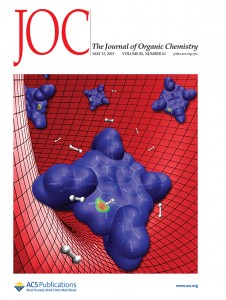Treatment of the oxime of octaethyloxochlorin under Beckmann conditions provided not the expected lactam, but the unprecendented octaethyl-1,3-oxazinochlorin, a chlorin analogue in which a pyrrole moiety of the parent oxochlorin was expanded by an oxygen atom to an 1,3-oxazinone moiety. Its mechanism of formation was demonstrated to occur along an “abnormal Beckmann” pathway, followed by intramolecular ring closure and hydrolysis. The work expands the methodologies known to convert octaethylporphyrin to pyrrole-modified porphyrin analogues with altered optical properties compared to the parent compounds.
Meehan, E.; Li, R.; Zeller, M.; Brückner, C. ‘Octaethyl-1,3-oxazinochlorin: A ß-Octaethylchlorin Analogue Made by Pyrrole Expansion’ Org. Lett. 2015, 17, 2210–2213. DOI: 10.1021/acs.orglett.5b00800.
Congratulations to Eileen’s and Ruoshi’s first paper from our group!
